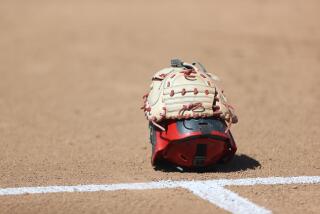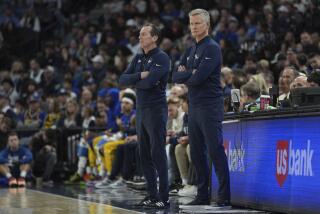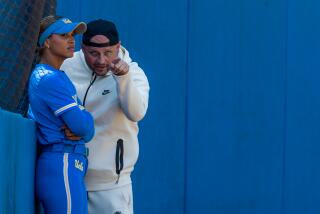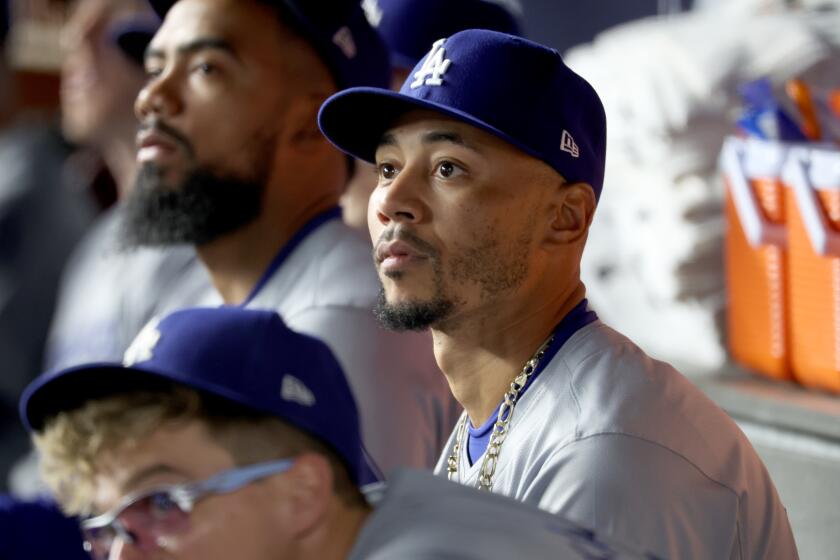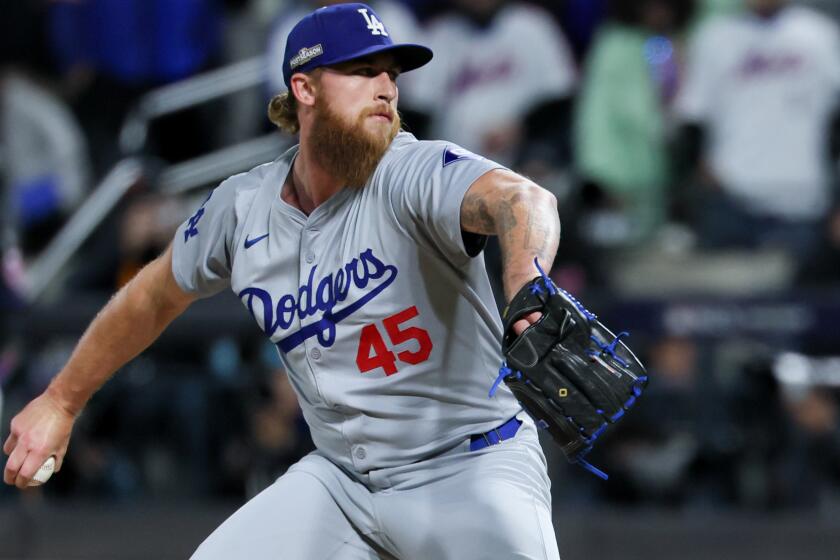Who’s on First? : There’s More to Being a First Base Coach Than Meets the Eye--but Not Much More
John Kruk, an outfielder for the Philadelphia Phillies, has been called a throwback to an another age, possibly the Stone Age. He’s one of the best hitters in the National League, but, judging by his looks, he would have made a great caveman. But there is one thing Kruk never would be.
“I don’t want to be no coach,” he said. “Don’t even want to think about it. I think about a lot, but never that.”
So consider for a moment the first base coach. All right, that’s long enough.
You see them standing there inside the chalk marks in foul territory next to the first base bag and you probably take them for granted. That is understandable. But is it also a huge mistake?
Just who are these first base coaches, and what do they do? What, that is, besides providing symmetry with the third base coach. You have a coach at third, so maybe you should have one at first, too. It’s sort of like evening up the layup lines in basketball.
For instance, take Ben Hines, the Dodgers’ first base and hitting coach. He said he is Manager Tom Lasorda’s second right-hand man, right after first right-hand man Joey Amalfitano, the third base coach. This probably would make more sense if Lasorda were not left-handed.
Anyway, Hines said, if you don’t know what you’re doing, then you just aren’t going to get to first base.
“I’m the guy who has to make sure that the guy at first base has the signs,” Hines said. “Bunt, hit and run, steal, squeeze. What we don’t want is the runner looking at the coach and asking, ‘Are you sure?’ ”
There probably are many others who aren’t entirely sure what a first base coach does. Be advised, then, that the job is absolutely loaded with responsibility and pressure--the responsibility of making sure there are enough baseballs for infield practice and, in the National League, at least, the pressure of getting the pitcher’s arms into the proper sleeves when he slips on his jacket at first base.
Bobby Knoop has coached first base for eight of the 15 years he has spent on the staff of the Angels. During that time, Knoop has informed, signaled, patted and cajoled legions of baserunners. But, proving that baseball is a funny game, Knoop recently experienced a first. Gary DiSarcina hit a line drive that ricocheted off Knoop’s knee.
“Never happened to me before,” Knoop said. “It was one of those that just kept following me. Too old to get out the way I guess.”
So coaching first base may also be hazardous to your health. And even if you keep your knees out of the way, there is a lot more to coaching first base than meets the eye.
Hugh Fink, a local comedian, has developed a routine about first base coaches. He said he became interested when he saw a game on television and the first base coaches wore microphones.
“For the first time, I was finally able to understand how much first base coaches contribute to strategy,” Fink said.
“It was like this for two hours:
Announcer: Now batting, Bobby Bonilla.
Coach: C’mon, Bobby . . . (clapping) . . . c’mon, Bobby.
Announcer: Now batting, Billy Ripken.
Coach: C’mon, Bobby . . . (clapping) . . . c’mon, Bob-o.
Announcer: Now batting, Andres Galarraga
Coach: C’mon, Bobby . . . (clapping) . . . c’mon Bobby.
And so on.
“You know when Joe Louis was signed by one of the big casinos in Las Vegas to shake hands at the door?” Fink said. “That’s what first base coaches are. They’re greeters. ‘Hello, how are you?’ They’re like the maitre’d of the diamond. They should have a tuxedo and a menu.”
Angel television broadcaster Ken Brett saw Fink’s act one night and met him afterward.
“Ken told me how much he enjoyed the show,” Fink said. “Then he said, ‘Listen, you know when a guy singles and is standing there on first and the first base coach leans over and says something quietly in the player’s ear, you know what he is saying? ‘Just one out.’ ”
So that’s one of his duties, telling the baserunner how many outs there are. This would be even more important if there weren’t scoreboards the size of Ventura County out there that keep track of the number of outs. Baserunners don’t know how many outs there are?
“You would hope that they all do, but they don’t,” Kruk said.
The first base coach has other responsibilities, broadcaster Joe Garagiola said, even if many people don’t realize it.
“That’s because first base coaches have as bad PR as a rattlesnake or a root canal,” Garagiola said. “He’s not just a foul pole if he’s worth anything at all.”
Garagiola thinks he has spotted a trend among first base coaches.
“Bobby Bonds, with the Giants, could be a whole new thing for first base coaches,” he said. “I did a game with the Padres where he was using hand signals to coach hitters, like his son, Barry.”
Coaching first base now is as big a job as when Garagiola was with the Cardinals and Clyde Ellsworth (Buzzy) Wares occupied the coaching box at Sportsman’s Park in St. Louis.
“Most people thought all he did was keep track of all the baseballs,” Garagiola said. “But Buzzy was sharp. If Red Schoendienst hit a ball off the right-field screen, a cinch double, Buzzy sometimes would stop Schoendienst at first so first base would be occupied and they would have to pitch to Stan Musial.”
Since Garagiola hit .194 in 1951 in his last appearance with the Cardinals, he found that the best place to get to know the base coaches was in the dugout.
“First base coaches were bare acquaintances,” Garagiola said. “First base coaches were in the witness protection plan. I didn’t see too much of them.”
Luis Pujols is in his first year as first base coach of the Montreal Expos. Besides playing an occasional game of catch with Manager Felipe Alou, Pujols considers helping runners with their leads to be one of the biggest parts of his job.
“It’s a little bit more than a pat on the butt,” Pujols said.
Pujols shared the technique he uses to prevent runners from getting picked off first base: “Back, back, back . . . but if the players wait for me to say it, it’s too late. I feel bad.”
Hines said he gets a lot of coaching help from the stands, usually about sending the runner on a steal attempt.
“You’d be surprised how many people are yelling, ‘Send him, Ben, send him,’ but I have nothing to do with that,” Hines said. “Sure, you get your ideas, but it’s not your game. It’s the manager’s game. For me, a good first base coach is a non-ego person. If you get too involved over there, it’s a mistake. You want to do as good a job as you possibly can and not be noticed.”
Lasorda was once a first base coach in the minors, so he can appreciate the nuances of the job.
“They’re a lot more important than people think,” he said. “They think that a first base coach is just down there for show or to fill in the other coaching box. That’s not so.”
So what do they do?
“How many outs--he has to constantly remind the runners how many outs there are,” Lasorda said. “And size of leads--a first base coach could lose ballgames for you just as well as win them. If he makes that guy hustle and the outfielder is laying back on the ball and he sees that and he allows that guy to get a double out of it, there is a good chance you’re going to win a ballgame doing that.”
Unless, of course, it’s the ninth inning and it’s 10-1. But in pressure-packed moments, the very ground the first base coach occupies becomes important. Oakland Manager Dick Williams left the dugout to stand in the first base coaching box for the A’s in the 1972 World Series against Cincinnati to protest the calls of umpire Jim Honochick.
“The plays didn’t look the same where I was sitting,” Williams said.
Williams was fined $200 for showing up the umpire.
It was Williams’ idea that his first base coaches have other duties, too. Thus, Jerry Lumpe and Jerry Adair also worked with the A’s infielders, and Bobby Tolan was Oakland’s hitting coach.
Lumpe provided another memorable first base coaching moment for Williams. With the bases loaded, Lumpe forgot what he was doing and caught a soft liner hit by Dave Duncan. The umpire ruled interference and called Duncan out.
What did Williams do?
“I laughed,” he said. “We had a big lead. Jerry said if there had been a hole there, he would have crawled in it. We all laughed. (Owner Charles) Finley didn’t care for it, though.”
From his house on a hill in Craftsbury, Vt., former major league pitcher Bill (Spaceman) Lee, who once called Boston Red Sox Manager Don Zimmer “a gerbil,” said that he has witnessed enough baseball to form an opinion on first base coaches.
Lee had just finished playing a pickup softball game but hadn’t done very well.
“I’m one step away from being a first base coach,” he said. “I’ll tell you, it’s one of the weakest jobs out there. Their prime responsibility is, when a guy misses a sign at first base, they yell at him.
“I’ll tell you, though, a good first base coach gets into the game, keeps the guy excited, makes him know how many outs there are, pats him on the back. He puts the jacket on the pitcher, picks up the batting helmets. He’s a gofer. Nowadays it’s a guy who carries the manager’s bag, makes sure all the balls don’t get stolen.
“First base coaches are ex-ballplayers who need jobs,” Lee said. “There are a lot of us out there.”
The first base coach for Philadelphia Manager Jim Fregosi is Mel Roberts, in his second season with the Phillies after 24 years as a minor league coach. Fregosi brought Roberts to the Phillies so he could qualify for a major league pension. Roberts, 50, needs two more years.
From where he stands, Knoop, 54, is happy with the view. Baseball people appreciate what he does, he said, even if others do not.
“I don’t want to sound curt, but if a civilian says to me, ‘Oh, well, you’re only the first base coach,’ that doesn’t mean anything to me,” Knoop said. “I could care less. I know what I do.
“If a person during the normal realm of a game observed me for a week, he’d probably say, ‘Yeah, he puts his hands on their shoulders, pats them on their behinds, waves his arms and points his fingers, yeah, he’s the first base coach.’ ”
C’mon, Bobby.
More to Read
Are you a true-blue fan?
Get our Dodgers Dugout newsletter for insights, news and much more.
You may occasionally receive promotional content from the Los Angeles Times.
